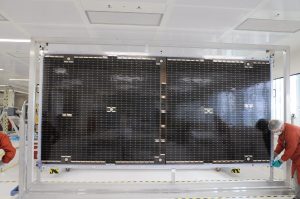The agency says the critical design review for the spacecraft’s platform has been completed, with the involvement of European industry partners and NASA.
The Platform Critical Design Review (P-CDR) confirmed the performance, quality and reliability of the systems for this unprecedented mission to Mars, said the ESA.
The validation of the design and technical details represent a formal step towards the integration phase.
European
Note that the Earth Return Orbiter (ERO) will be the largest spacecraft ever built for interplanetary flight. As well as the UK, European contributions come from France, Italy, Germany, Spain, Switzerland, Norway, Denmark, Belgium, Romania, and The Netherlands.
The manufacturing and testing of the components of the spacecraft will now start for the mission to move towards launch.
Airbus Defence and Space has overall responsibility for the ERO mission to build the spacecraft and to conduct mission analysis from France, Germany and the UK. Thales Alenia Space will also be assembling the spacecraft, developing the communication system and providing the orbit insertion module from its plant in Turin, Italy.
“The configuration of the spacecraft is robust enough to be flexible with the cargo and to help finding solutions for a new architecture. ESA and our industrial partners adapted to a new scenario, staying inventive and resourceful while remaining a reliable partner for NASA,” said Tiago Loureiro, ERO’s project team leader..
“We have confirmed that the Earth Return Orbiter works for what was planned to do and more, whatever the alternatives are,” he adds.
Earth Return Orbiter
Pictured above is ERO’s first solar array panel. The seven-tonne, seven-metre tall spacecraft will be equipped with 144 m² of solar arrays and nearly 40 000 individual solar cells, spanning nearly 40 metres.
The Earth Return Orbiter (ERO) is ESA’s major contribution to Nasa’s Mars Sample Return campaign, described as “a complex choreography of missions to bring martian rock, soil and atmospheric samples back to Earth”.
Very basically, samples collected on Mars by NASA’s Mars Perseverance rover will be handed to another orbiter on the Red Planet that will then fire a rocket, the payload of which will contain the rocks. In turn, this will captured mid-space by the European Earth Return Orbiter, which will fire the captured samples back to Earth. See the video below.
You can read more on the ESA website.
Image: ESA
See also: ESA, NASA ramp up co-operation to land Europe’s ExoMars rover on Mars
 Electronics Weekly Electronics Design & Components Tech News
Electronics Weekly Electronics Design & Components Tech News




